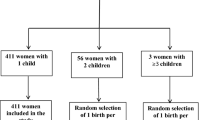Abstract
HIV/AIDS in children has emerged during third phase of HIV epidemic as a result of high level of infection in women of child bearing age. Now it is being detected at an alarming rate. Various methods of HIV/AIDS transmission, prevalence of HIV in multitransfused, modes of prevention and control of HIV infection in children, antenatal care of HIV positive women, infant feeding options, safe blood along with other intervention have been reviewed.
Similar content being viewed by others
References
SK Kabra, A Singh, Y. Jain. HIV/AIDS in chlidren.J Inter Medical Sci Acad 1998; 11:179.
UNAIDS and WHO, AIDS Epidemic Update Geneva. Dec; 2002.
Sen S, Mishra NM, Giri Tet al. AIDS in multitransfused children in thalassemia.Indian Pediatr 1993; 30: 455–460.
Singh S, Gulati S, Marwaha RK, Garewal G, Kumar L, Sehgal S. HIV Serosurveillance in multi transfused thalassemic children.Indian Pediatr 1993; 30:104–105.
Singh S, Ahlawat S, Singh N, Choudhry VP. TORCH seroprevalence rate in multiple transfused beta thalassemic chidlren in India.Eur J Hematology 1995; 54: 64–66.
NACO-Combating HIV/AID in India 1999-2000; 12–13.
Sen S. Pediatric HIV infection: Recent advances.Indian Pedaitr 1995; 32:519–525.
NACO-Combating HIV/AIDS in India 1999-2000; 7.
NACO-HIV/AIDS surveillance in India (as reported to NACO) as on March 31, 2003.
NACO-A report of WHO sponsored workshops on STD/HIV-Diagnostic Techniques year 2001 page 37.
NACO 3-feasibility study of administering short term AZT interention among HIV infected mothers to prevent mothers to child transmission 3-Page 3.
Newell ML. Mechanisms and timing of mother to child transmission of HIV-1.AIDS 1998; 12: 831–37.
Anonymous. Children with HIV/AIDS: Challenges and opportunities.ICMR Bulletin 1997; 27:117–127.
Nielsen K, Bayer P, Dillor M,et al. Presence of HIV-type I and HIV-I specific antibodies in cervico vaginal secretion of infected mothers and in the gastric aspirates of their infants.J Infect Dis 1996; 173:1001–1004.
Landesman SH, Kalish, LA, Burns DNet al. Obstetrical factors and the transmisson of HIV-I from mother to child. The women and infants transmission study.N Engl J Med 1996; 334: 1617–1623.
Dunn DT, Newell ML, Ades AE, Pectham CS. Risk of HIV type 1 transmission through breast feeding.Lancet 1992; 340: 585–588.
Nagekerke NJD, Moses S, Embree JEet al. The duration of breast feeding by HIV-1 infected mother in developing countries. Balancing benefits and risks.J Acq Imm Def Synd Hum Retrovis 1995; 8:176–181.
Vande Perre P Simonon A, Hitimana DGet al. Infective and antiinfective properties of breast milk from HIV-I infected women.Lancet 1993; 341: 914–918.
Sengupta B, De M, Lahiri D, Bhattacharya DK. Sero surveillance of transmissible hepatitis B and C viruses in asymptomatic HIV infection in hemophilics.Ind J Med Res 1992; 95:256–258.
De M, Banerjee D, Chandra S, Bhattacharya DK. HBV and HIV seropositivity in multitransfused hemophiliacs and thalassemics in Eastern India.Ind J Med Res 1990; 91: 63–68.
Singh YN, Bhargava M, Malviya AN. Tripathy SP, Kakkar A, Khare SD. HIV infection in Asian Indian patients with hemophilics and those who had multiple transfusions.Ind J Med Res 1991; 93:12–14.
Chandra C, De M, Banerjee D, Bhattarcharya DK. Emergence of seropositivity for HIV in multiitransfused hemophilics of Eastern India in XXX Annual Conference of Indian Society of Hematology & Blood Transfusion Behrampur 1989; 47.
Kumar RM, Uduman S, Hamo IM, Morrison J and Khurana AK. Incidence and clinical manifestations of HIV -1 infection in multittansfused thalasemic children.Trop George Med 1994; 46:163–166.
Chopra A, Nadkarni UB and Kshirsagar S. Prevalence of hepatitis C virus infection and its comparison with HBV and HIV infection in multitransfused thalassemia major children in 35th National Conference of IAP Cochin (Abstract) 1998 p 34.
Choudhury N, Saraswat S, Naveed M. Serological monitoring of thalassemia major patients for transfusion associated viral infecitons. Indian J Med Res 1998:107;263–268.
Sharma K and Sharma DB. HIV, hepatitis B, hepatitis C Screening in multitransfused thalassemic children in 39th National Conference IAP (Jaipur). Abstract 1999 HO-p 03.
Chandra S, Das MK and Banerji. The seroprevalence of hepatitis B, hepatitis C and HIV in thalassemic population of Eastern India in 7th International Conference on Thalassemia and the hemoglobinopathies. Bangkok Thailand (Abstract) 1999; 352.
Choudhry VP, Kashyap R, Acharya Sk. Management of thalassemia. In Gupta S, ed.Recent Advances in Pediatrics. Jaypee Brothers Publications 2000 vol. 10, p 179–194.
National AIDS control programme Country Scenario: an update publication of National AIDS Control Organization and Ministry of Health and Family welfare 1996; 8.
NACO Country Scenario publication of 1997 2–1998; 18.
NACO Country Scenario publication of 1998 2–1999; 12.
NACO combating HIV/AIDS in India. 1999 2–2000; 7.
NACO as on Feb 2002.
HIV/AIDS surveillance in India as on March 2003-NACO.
Family Health International 2003. Reducing mother to child transmission of HIV.
UNAIDS/UNICEF/WHO. HIV and infant feeding Geneva 1998.
Coutisoudis A, Pillay K, Spooner Eet al. Inherence of infant feeding patterns on early mother to child transmisison of HIV-I in Durban, South Africa: a prospective cohort study.Lancet 1999; 354:471–476.
St. Louis MB, Kemenga M, Bendayo Jet al. Risk for perinatal HIV-I transmission according to maternal immunologie and placental factors.JAMA 1993; 269: 2853–2859.
Minol H, Burns ON, Lendersmen Set al. The relationship of the duration of ruptured membrane to vertical transmission of HIV-I.Amer j Obst, Gynaecol 1995; 173: 585–589.
Dunn DT, Newell ML, Mayavx, MJet al. Mode of delivery and vertical transmission of HIV-I. A review of prospective studies.J Acquire Immuno Deficiency Syndrome 1994; 7: 1064–1066.
Mondelbrot L, Mayauz MJ, Bongain Aet al. Obstetric factors and mother to child transmission of HIV-I: The French perinatal charts.Am J Obstet and Gynaecol 1996; 175: 661–667.
Semba RD, Miotti PG, Chiphangwi JDet al. Maternal vitamin A deficiency and mother to child transmission of HIV-I.Lancet 1994; 343:1593–1597.
NIH Guide.In vitro inactivation of viruses in blood components.Release date Jan 18; 2000.
Author information
Authors and Affiliations
Rights and permissions
About this article
Cite this article
Choudhry, M., Choudhry, V.P. Prevention and control of HIV/AIDS. Indian J Pediatr 70, 975–981 (2003). https://doi.org/10.1007/BF02723824
Issue Date:
DOI: https://doi.org/10.1007/BF02723824




